Microsoft Announces the Surface Pro 4, from $900
by Ian Cutress on October 6, 2015 1:30 PM EST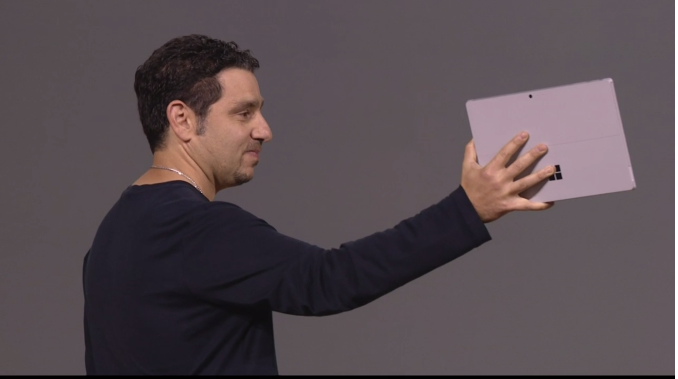
Devices Day at Microsoft grows every year. We have seen the numerous Surface announcements come through the special event held in NYC, as well as the peripheral devices around the ecosystem and a few smartphones as well. As this is the first Device Day after Windows 10 launch, we were greeted with numbers and facts about Windows 10 adoption rates, such as 110 million Win10 installs in 10 weeks, 1 billion questions asked through Cortana and 1.25 billion visits to the Microsoft app store. While the Surface Book announcement arguably stole the show, the big presentation everyone was expecting was for the new Surface Pro 4.
Panos Panay exalted the virtues and successes of the Surface Pro 3, such as the march towards 98% of users recommending the device. However the Surface Pro 4 aims to break such records. The device itself looks like an upgrade of the SP3, featuring 500 unique parts, however due to Intel’s major release of their 6th Generation Core platform, the SP4 was expected to get the whole platform upgrade. As a result we will see SP4 devices with Core M (Intel’s 4.5-watt platform), Core i5 and Core i7 processors up to 15W and ‘up to nine hours’ of battery life.
The Core i7 models will have Iris integrated graphics, which is part of Intel’s eDRAM strategy and we assume at this point that they will have 64MB of eDRAM. Microsoft showed the three-chip SoC in one of their presentation slides:
From 12-inches in the SP3 to 12.3-inches in the SP4, we are told that the device itself is not any bigger as Microsoft were able to reduce the size of the bezels. The display optical stack is also thinner than before, with Microsoft saying it is the thinnest optical stack ever fitted and comes with Microsoft custom silicon in the form of a G5 processor to help drive the display. The chassis is machined magnesium with the same SP3 kickstand that allows multi-position configurations. The SP4 comes in at 8.4 mm thick and a hybrid cooled system as well. The display retails the 3:2 aspect ratio of the SP3 but boasts a ‘5 million pixel display’, or 2736x1824 in numbers, with PixelSense. Each display is 100% sRGB with individual calibration, but also features 10-point multitouch.
| Microsoft Surface Pro Comparison | ||||||||||
| Pro 4 | Pro 3 | Pro 2 | Pro | |||||||
| Dimensions | 11.5 x 7.93 x 0.33" | 11.5 x 7.93 x 0.36" | 10.81 x 6.81 x 0.53" | |||||||
| Display | 12.3-inch 2736 x 1824 |
12-inch 2160 x 1440 |
10.6-inch 1920 x 1080 |
10.6-inch 1920 x 1080 |
||||||
| Weight | 1.69 lbs (m3) 1.73 lbs (i5/i7) |
1.76 lbs | 2.0 lbs | 2.0 lbs | ||||||
| Processor | Core m3, i5 or i7 | Core i3, i5 or i7 | Core i5 | Core i5 | ||||||
| Cameras | 8MP / 5MP (front/rear) |
5MP/5MP (front/rear) | 1.2MP/1.2MP (front/rear) | 1.2MP/1.2MP (front/rear) | ||||||
| Connectivity | 2T2R 802.11ac | 2T2R 802.11ac | 2T2R 802.11n | 2T2R 802.11n | ||||||
| Memory | 4GB, 8GB or 16GB LPDDR3 | 4GB or 8GB LPDDR3 | 4GB or 8GB LPDDR3 | 4GB | ||||||
| Storage | 128, 256, 512GB or 1TB PCIe 3.0 |
64, 128, 256 or 512GB | 64/128GB or 256/512GB |
64GB or 128GB | ||||||
| Battery | 'up to 9hrs' | 42.0 Wh | 42.0 Wh | 42.0 Wh | ||||||
| Starting Price | $899 | $799 | $899 | $799 | ||||||
The hardware will also come in 4GB, 8GB and 16GB models for DRAM, paired with 128GB, 256GB, 512GB or 1TB of PCIe 3.0 based SSD storage. We would assume this is PCIe 3.0 x4 in line with current high end storage in other PCs, although Microsoft does not specify at this point. 802.11ac 2T2R WiFi comes as standard with MIMO enabled.
Cameras come in the form of an 8MP rear facing auto-focus and a 5MP front-facing camera, both capable of 1080p. Nothing special was made about the microphones, but the SP4 comes with a full-size USB 3.0 port (note no USB 3.1 or Type-C here). Other inputs include a mini-DisplayPort for external displays, headphones/microphone jack and the Surface Connect for movement out to an external dock capable of driving more screens and USB ports.
The new Surface Pen is an upgraded model, featuring 1024 levels of pressure sensitivity and is presumably a derivative from Microsoft’s acquisition of pen technology from N-Trig. Microsoft will offer several colors of pen, and adjustable tips to account for the feel of the pen. On stage we noted that these will be labelled similar to pencils, and Microsoft will offer B, HB, H and 2H alternatives but prices were not announced for these. The pen is stored by magnetic attachments to the SP4, rather than a storage bay
New Type Covers are inbound as well, featuring a new switch design that facilitates quiet operation and 1.3 mm travel due to a new scissor design. The keyboard is backlit, and the trackpad is 40% larger than previous type covers. It is also worth noting that the trackpad uses precision glass, which Microsoft claims should give a more accurate representation when used. They weren’t 100% clear on the use of fingerprint sensors on trackpads, but there seems to be some versions with fingerprint sensors enabled as well. No pricing was given on the new Type Covers.
The basic SP4 box will come with the device, a Surface Pen and a power supply (24W with Core m3, 36W with i5/i7 that also has a USB charging port). Prices will start from $900 and go up to $2200, with pre-orders starting on October 7th. Devices will be available from October 26th, but Microsoft failed to mention which regions they would be available, so given the price information we could assume it might be a US/NA initial launch at this point with other regions to follow. If we get more information on this, we will update this post.
| Microsoft Surface Pro 4 Configuration Options | |||||||||||||
| Configuration | $899 | $999 | $1299 | $1599 | $1799 | $2199 | $2699 | ||||||
| CPU | Core m3 | Core i5 | Core i5 | Core i7 | Core i7 | Core i7 | Core i7 | ||||||
| TDP | 4.5W ? | 15W ? | 15W ? | 15W ? | 15W ? | 15 W ? | 15 W ? | ||||||
| Cores/Threads | 2/4 | 2/4 | 2/4 | 2/4 | 2/4 | 2/4 | 2/4 | ||||||
| GPU | Intel HD 515 | Intel HD 520 | Intel HD 520 | Intel Iris 540 | Intel Iris 540 | Intel Iris 540 | Intel Iris 540 | ||||||
| GPU EUs | 12 | 24 | 24 | 48 | 48 | 48 | 48 | ||||||
| eDRAM | None | None | None | 64 MB | 64 MB | 64 MB | 64 MB | ||||||
| Storage | 128 GB | 128 GB | 256 GB | 256 GB | 256 GB | 512 GB | 1 TB | ||||||
| RAM | 4 GB | 4 GB | 8 GB | 8 GB | 16 GB | 16 GB | 16 GB | ||||||
At this point the exact CPU models are unknown, or whether each device will use some form of cTDP Up or cTDP Down to align with the chassis. One would assume the Core m3 is in cTDP Up mode to align with the performance of the others, though the battery life of the Core m3 device would be interesting nonetheless as the CPU draws less power overall. We will have to try and source at least one m3, i5 and i7 due to the configuration differences for review.


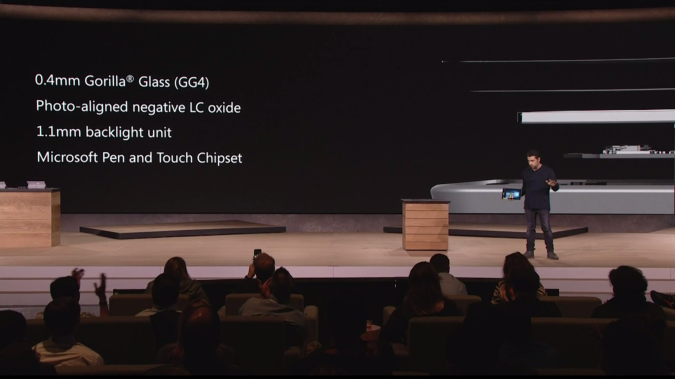
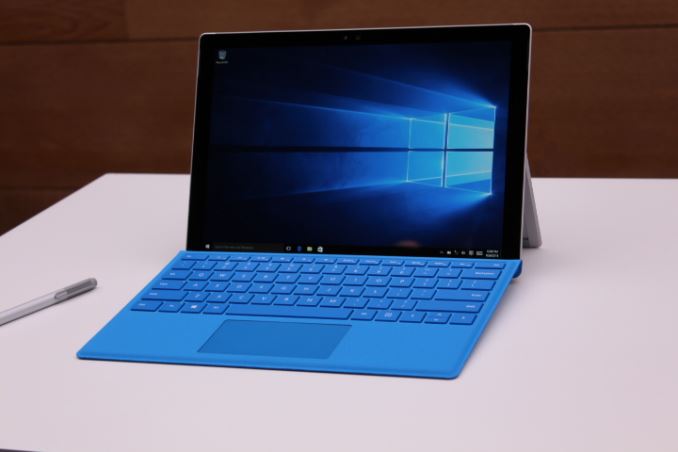
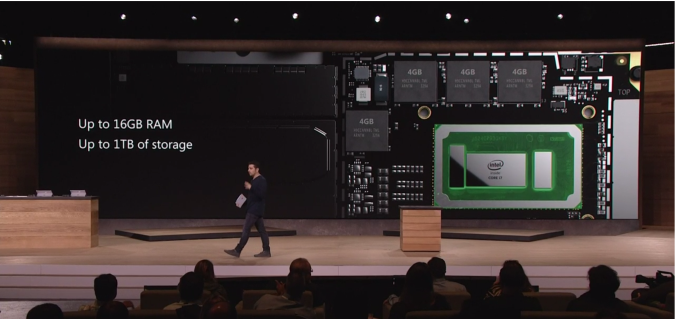
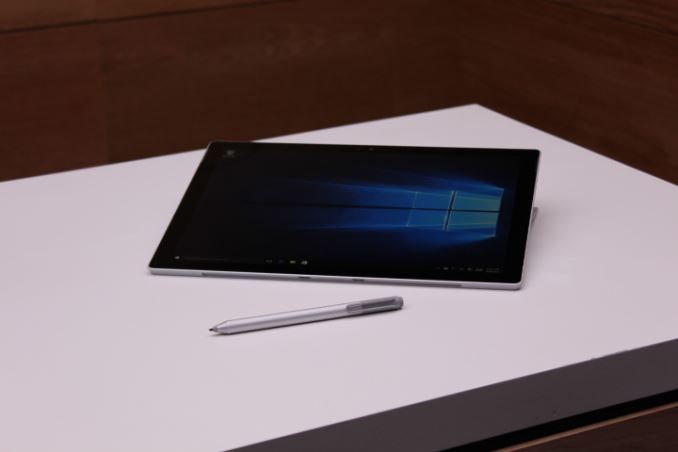
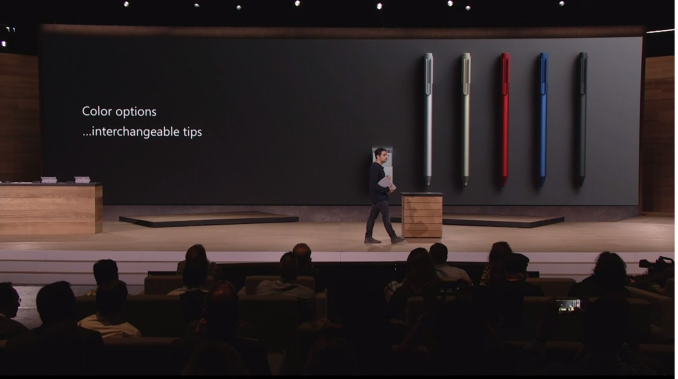
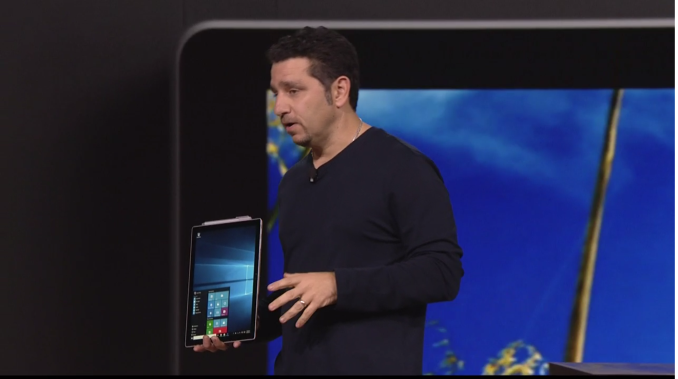















93 Comments
View All Comments
nerd1 - Tuesday, October 6, 2015 - link
It's absurd that they tout the SP4 is 50% faster than MBA, which is thermally not possible. SP3 throttled when the core hit around 80 deg celcius, and MBA goes up around 100 deg, allowing higher clock speed for longer time.BurntMyBacon - Wednesday, October 7, 2015 - link
@nerd1 I agree with your initial claim. The very marketing oriented 50% faster claim is marketing and should be given no credence. However, I also have to call you out on your thermal throttling argument. Had you said the MBA had a better cooling solution and keeps the processor further below the thermal shutdown threshold, I'd check it out, but it sounds like it could be true (larger surface area). However, you suggest that two devices that both use Intel silicon will have wildly different thermal shutdown thresholds as conveyed by the wildly different throttling temperatures (80C vs 100C). Granted the processors are one generation apart, but they are in the same class of product and have very similar thermal shutdown thresholds. If such a wild variation in throttling temperatures really does exist (and isn't modifiable in BIOS) then you have to consider what is happening to that MBA that is allowed to heat up so much closer to its thermal shutdown temperature. Perhaps you should look up what happens to the life expectancy of silicon devices with every 10C rise in temperature.Note: I have not yet formed an opinion of the SP4 vs SB vs MBA vs iPAD Pro. I will save an opinion for after reviews, though my initial thoughts are upgrades from the base model on all of these lines are stupid expensive owing to the fact that none of them support after market upgrades.
nerd1 - Wednesday, October 7, 2015 - link
SP3 thermal threshold is lower than laptops because the screen is right next to the chip. My SP3 hovered around 2.0~2.2Ghz under full load.BurntMyBacon - Friday, October 9, 2015 - link
That makes a lot more sense. So they didn't put a good enough insulation layer between the heat sources and the display. Still better to limit performance than to destroy the device over time. Need to consider the performance implications for the newer surface devices.coolhardware - Tuesday, October 6, 2015 - link
What size screen were you wanting? This is the largest screen surface tablet they have ever made: http://pixensity.com/search/?search=surfaceExpensive yes, but they seem to be wanting to target their "Pro" tablet at businesses and that makes some sense.
Were you just looking for a lower price point or were there other significant features they missed? (Beyond USB-C and LTE).
Apple charges a fairly high price for the iPad "Pro" and it seems *more* limited in many areas.
PS does anybody know how the speakers are in Surface Pro 4???
Prod1702 - Saturday, October 10, 2015 - link
I am wondering on the speakers as well. I will use headphones but having nicer speakers is nice.rahvin - Tuesday, October 6, 2015 - link
No USB Type C or USB 3.1 is just fucking stupid. Instead there is this "Microsoft Connect" port which is a proprietary garbage. It won't be long before all USB parts are type C, it's certainly going to happen in the lifetime of this product (unless you buy a new computer every year). I expected Microsoft to get this right where Apple screwed up with a single port. Instead they didn't even get close to right by completely leaving USB 3.1 off and adding a bogus proprietary port.I'm simply shocked at the stupidity. It's a great product but it's worthless without USB C, at least IMO.
digiguy - Tuesday, October 6, 2015 - link
It's not worthless but loses a lot of value. USB 3.1 would definitely make sense with a PCIe SSD and make it future proof. Same for the surface book. It's probably worth waiting for the next generation of both, especially if you already have a SP3. In the meantime I will be buying the new type cover for my SP3...Chris_Kez - Wednesday, October 7, 2015 - link
I think we all want the latest (e.g. Type C) but I have to think that Microsoft has some idea of the needs of their target/core buyers. In business and enterprise, for example, what percent of peripherals will use a Type C connector even three years from now?rahvin - Wednesday, October 7, 2015 - link
In 3 years 90% of all peripherals will be using type C. Every phone produced in 2016+ will have it. Up until a couple weeks ago there was only one chip supplier so prices remained high, two more went full production a couple weeks ago. By the end of the year USB C will be as cheap to use as USB 3.0 and it's going to virtually eliminate all other forms of USB in very short order.It was beyond stupid for MS to leave the port off. The very least they could have done is match apple and used the USB C port for the power. One of the beauties of USB C is the power, now the big power brick you have to carry around with your laptop could actually have more USB ports on it because the power it supplies is via USB-C. This would allow the power brick to essentially provide a docking station like functionality because you have to carry it around anyway.
I thought Apple screwed up big time when they included only one port, I though Google stumbled with the Pixel when they only provided two but I had no idea microsoft would be so stupid as to not include any. Any tablet or laptop coming out in the next few months should have at least 2 usb C ports and preferably 3+. Not including them is so shortsighted it's just unbelievable.